Midnight Riders celebrates over 50 years
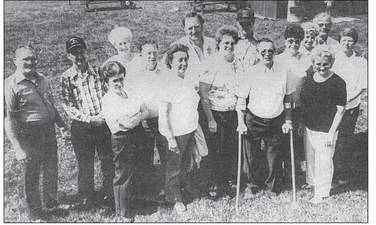

Dorchester based snowmobile club began in 1970
The 1970’s were an important time for central Wisconsin. Organizations in and around the Abbotsford, Colby, Dorchester and Unity communities planted seeds that sprouted deep roots, and many of those same organizations are still flourishing five decades later. In Abbotsford, Creative Automation opened shop and began production. It was in the early 1970’s when the O’Leary family purchased the Tribune-Phonograph and The Record-Review.
In Unity, Ray Gurtner opened up Ray’s Market, and while the location has since moved to Colby, and Ray’s son, Alan, has retired from the business, the fragrant smells continue to linger in the air under new direction, but with the same name and time honored recipes.
Just as those businesses were getting started, a group of snowmobile enthusiasts from Dorchester got together to form a club, and what began with 15 has grown to an impressive organization with over 100 members that spans five decades.
The club would eventually call itself by a unusual name - the Midnight Riders.
“How we came up with the name Midnight Riders is because we didn’t get started until around 10 o’clock at night,” charter member Tom Reynolds explained. “Then we would ride until 2-2:30 in the morning.”
“There were a lot of farmers, so around 9 p.m., when their chores were done, the farmers could go, and they didn’t have to be back until chores in the morning,” current member and former officer Dave Bedroske said.
The club’s formation began at the same time as the snowmobile boom of the 1970’s Lester Bowman owned a local dealership in Curtiss, and before long, Bowen had everyone buying snowmobiles.
“It was about 1969 when everyone bought a snowmobile,” Reynolds said. “Everyone had a Ski-Doo back in them days.”
Having a snowmobile was nice, but the one thing that was missing was a decent trail to ride on.
“Back in those days, we had to run the road a lot,” Reynolds said, meaning snowmobilers had to resort to riding along road ditches, roads and railroad right of ways.
“I can remember coming back from Cherokee one time, and the blacktop was bare so we had to ride the shoulders,” Reynolds said with a chuckle. “If you saw a mailbox you’d have to duck so you wouldn’t hit your helmet, and we didn’t have the helmets like they do today. I almost lost my head a couple of times.”
It quickly became apparent to fans of snowmobiling in Clark and Marathon counties that some organization should be in charge of grooming trails and to help encourage others to take up snowmobiling as a hobby. “Everybody started to say we should have a trail, and people started to wonder whose lands they could go on,” Bedroske said. “Guys that owned snowmobiles would tell their buddies ‘You can ride on my land.’” The first meeting of the Midnight Riders was held on May 15, 1970, in the home of Russell Rueden in the township of Holton. Jerome Gebert suggested the name, and it stuck, and was subsequently adopted, along with the logo of a snowmobiler riding toward the moon.
The first officers were Lawrence Stelzel, president, Jerome Gebert, vice president, Thomas Reynolds, treasurer, Patti Ellenbecker, secretary and directors Russel Rueden, William Gumz and Kenneth Ellenbecker.
A document dated from Oct. 14, 1970, from Wisconsin’s department of state recognized the Midnight Riders, and six days later, Vern Hansen, the Clark County register of deeds at that time, recorded the state’s approval in the county seat of Neillsville. From then on the Midnight Riders were officially recognized.
According to the incorporation papers of the Midnight Riders, their purpose for forming the club was, “To provide opportunity for all persons interested in snowmobiling to associate for common enjoyment . . . to promote the sport of snowmobiling . . . to establish trails for safe operation of snow vehicles and to have members and snowmobiles available to assist authorities in times of emergency.”
“Besides bylaws you do articles of confederation, and they drafted those documents up,” Bedroske explained. “When they got together, part of the deal was to try and get funding because if they were going to have equipment to groom trails, it was going to cost some money.”
Reynolds recalls that snowmobile clubs were so desperate for grooming equipment, some groomers resorted to pulling bed springs behind their snowmobiles to smooth trails.
The Midnight Riders were fortunate to have Melvin Fischer as part of their organization, says Reynolds, “Mel built what we called the Clyde, a half track, and all kinds of junk.”
Securing funding was always the biggest hurdle for the Midnight Riders. While the state and county gave snowmobile clubs some funding, it wasn’t nearly enough to account for the expenses that grooming entailed.
Fundraisers were a hot topic in the club’s first year, and the club also hosted races. In 1971 the Midnight Riders held their first Snowmobile Rally. In Feb. 1973, 86 entrants registered for the first of several Grand Prix races.
The races attracted large crowd from all parts of Wisconsin and nearby states, but money was not to be found in local races, and by 1979 the club held their last Grand Prix.
A look at the early minutes of the club’s existence shows plenty of repairs and equipment purchases. And while those early repair jobs were only around $20 to $30, this was an era when the minimum wage was just under $2 an hour.
“It always took money,” Bedroske said. “They always wanted more grooming equipment, and you had to raise the money for it. Other things that happened at that time, was pretty soon you wanted to go farther. Well, how can you connect with other trail systems?
“So both Clark and Marathon counties formed snowmobile councils, and all the clubs joined the council so they could network with other clubs in the county.”
Securing funds and grooming the trails continued to be the number one priority for the club.
Lawrence Stelzel attended a DNR meeting in 1975, where the idea of funding for trail expenses was floated about, but it would take six years before the DNR would make good on that offer.
The funding proved beneficial in obtaining grooming gear. For the club’s first eleven various drags were built, with various degrees of success.
While the Midnight Riders weren’t resorting to old bed springs anymore, with the DNR now involved, there were regulations to follow for grooming trails.
With some funding secured from the DNR, the Midnight Riders purchased a eight foot hydraulically operated straight blade and a 24 horse power crawler with tracks that became known as the Midnight Hustler.
The Hustler did not perform very well and was soon replaced with Weasel Crawler that was referred to as Clyde. In time, Clyde gave way to Bonnie in 1984, which was a specially made grooming machine developed by Mel Fischer.
By 2001 a 1999 New Holland tractor was purchased, and this has been in use for over twenty years, though Bedroske noted the time is coming for a new groomer.
“In ’70-71 we started with 15 members,” Reynolds said. “It was $10 for a family and $7 for a single. We started good, and it grew.”
The Midnight Riders has steadily grown to its present membership of right around 100 members, and Reynolds and Bedroske have said the club has had a bit of a resurgence as a newer generation gets into the snowmobiling. Bedroske and Reynolds says economics has been an issue for recruiting new members.
“A lot of people that had snowmobiles back then, but like anything else, a lot of people quit snowmobiling for health reasons or economic reasons.”
“We paid $500 to $1,000 for a snowmobile at the beginning, depending on if it was used or new it usually ran around $800,” Reynolds said. “But nowadays it seems you can’t hardly touch one for four digits anymore.”
The Midnight Riders were able to weather the ups and downs of the past 50 years, and club membership has been pretty consistent. Members get together on a regular basis throughout the year.
“Beer has something to do with it,” club member Dennis Reynolds says with a chuckle.
Indeed, parties and get-togethers became synonomous with snowmobiling, especially the Midnight Riders’ infamous “swamp parties” so called because they often took place outdoors and in the woods or swamps.
Not even the cold weather could stop the Midnight Riders from having a good time, and the Jan. 16, 1976 minutes even made mention of a party held by Dale Geiger that saw 40 people brave -10 degree temperature.
But the club also found a way to avoid nasty politics, and Bedroske said this has kept grudges from forming and new ideas to filter in.
“We have term limits, so you can only serve two terms in succession in any one office, and then you have to step down,” Bedroske said. “So this keeps things fresh. The clubs that I see struggling have the same people as president year after year, and that seems to hurt them. Everybody supports each other, and a change in officers brings in new ideas.”
Plans for the future
Fundraisers and raffles continue to be the club’s biggest money makers, and the club continues to add equipment to ensure Clark County has some of the best groomed trails in the state.
It’s been that way for 50 years, and it will likely go on that way for 50 years.
In honor of the last five decades, the Midnight Riders will be holding a belated 50th anniversary after COVID-19 forced the club to halt festivities these past two years.
Tom Reynolds, now 91, to represent the charter members, and Bedroske said the 50th anniversary is in many ways a celebration of that original group.
“We certainly want to acknowledge Tom and the charter members for being a group that saw the future there and the need to organize and get a club going.
“The fun aspect had a lot to do with it, but we also want to celebrate snowmobiling, it enabled them to build an organization that now has 35 miles of trails, with almost all of it funded.”
“We’ve got good, dedicated workers,” Bedroske says. “Our groom operators don’t get paid for running the groomers. It takes a lot of hard-working people to keep something going for fifty years.”
Ultimately, the story of the Midnight Riders is more than grooming and snowmobiles. It’s the story of a close-knit group of people who share passion and have stepped in to fill that need so that others can take part in that passion.
So long as that passion remains with the Midnight Riders, there’s every chance the club will celebrate 100 years.
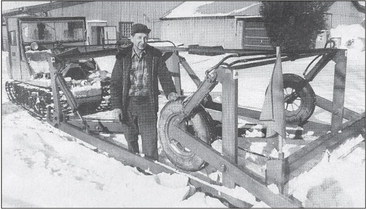
GET IT DONE -Melvin Fischer, a founding member of the Midnight Riders snowmobile club of Dorchester stands with his new trail drag and the club’s weasel machine in January of 1985. The weasel crawler was dubbed “Clyde” by the members, and another grooming machine was named “Bonnie.”
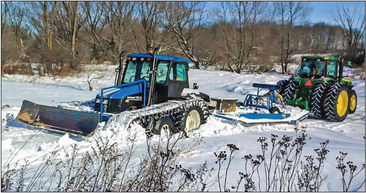
MODERN EQUIPMENT -The Midnight Riders of Dorchester are going strong even after five decades. The club has weathered storms - both figurative and literal, and year after year its members continue to groom trails for snowmobile enthusiasts. The club now signs and grooms 35 miles of trails in Clark and Marathon counties and has around 100 members. SUBMITTED PHOTOS
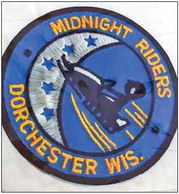
OFFICIAL LOGO -Charter member Jerry Gebert chose the name Midnight Riders, and a snowmobile riding towards the moon became the logo.
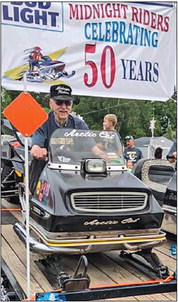
STILL GOING - Above, charter member Tom Reynolds “rides” charter member Lawrence Stelzel’s 1970 snowmobile in the 2021 Dorchester Days Parade. The Stelzel family recently donated the snowmobile to the club, and Reynolds remains an active member.
